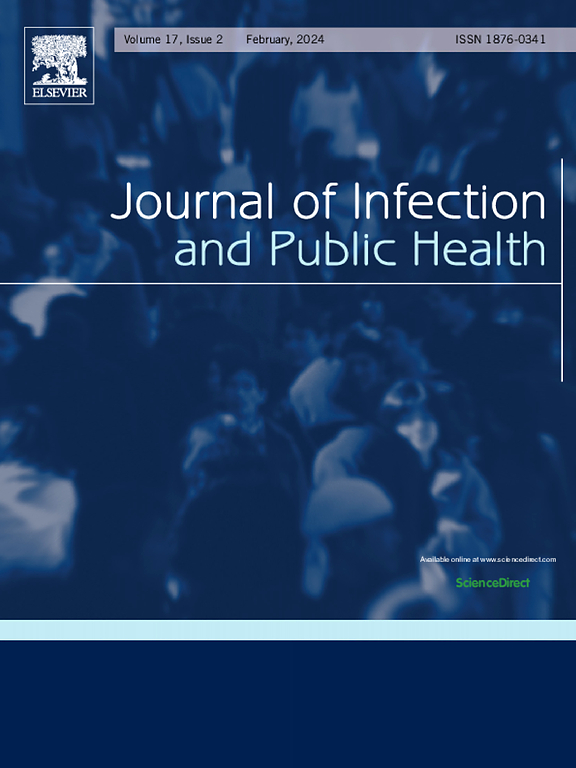Genomic approach to evaluate the intrinsic antibacterial activity of novel diazabicyclooctanes (zidebactam and nacubactam) against clinical Escherichia coli isolates from diverse clonal lineages in the United Arab Emirates
IF 4.7
3区 医学
Q1 INFECTIOUS DISEASES
引用次数: 0
Abstract
Background
The spiking rise in the prevalence of multidrug-resistant (MDR) pathogens necessitates discovering new antimicrobial agents. This study aims to investigate the intrinsic activity of two novel diazabicyclooctane (DBO) β-lactamase inhibitors, zidebactam and nacubactam, against diverse MDR Escherichia coli isolates from the United Arab Emirates. We aimed to correlate their antibacterial efficacy with the genomic characteristics of the strains.
Methods
This study investigated 73 E. coli strains and tested them for susceptibility to different antibiotics, including DBOs. PCR screening for carbapenemase and major β-lactamase genes was done. The strains were then grouped according to phenotypic and genotypic profiles. Whole-genome sequencing was employed to characterize the genetic landscape and clonality of selected 32 strains. Additionally, time-kill studies were conducted to confirm the bactericidal activity of DBOs.
Results
Zidebactam demonstrated superior efficacy compared to nacubactam, primarily due to its higher affinity for penicillin-binding protein 2 (PBP2). Notably, zidebactam alone exhibited the most potent in vitro activity, outperforming both traditional β-lactams and novel antibiotics like cefiderocol. DBOs maintained effectiveness against strains harboring various resistance determinants, including NDM-5, OXA-181, CTX-M-15, SHV-12, CMY, and DHA. Genomic analysis revealed multiple mutations in PBP1–3, with PBP2 mutations correlating with DBO susceptibility variations. Importantly, DBOs remained highly effective against isolates with PBP mutations, even those belonging to high-risk clonal lineages (ST167, ST410, ST131). Time-kill studies confirmed the bactericidal activity of DBOs, with only one strain showing reduced susceptibility (MIC: 4 µg/ml).
Conclusions
This study provides compelling evidence for the potential of DBOs, particularly zidebactam, as novel antibacterial agents. Their unique characteristics and broad-spectrum activity position them as promising candidates for future antibiotic development. While the inclusion of DBO therapies in the antibiotic arsenal could significantly impact MDR pathogen treatment, realizing their full potential requires further research, clinical evaluation, and vigilant monitoring of resistance mechanisms through integrated genomic approaches.
基因组学方法评估新型重氮达比环辛烷(齐地巴坦和纳库巴坦)对来自阿拉伯联合酋长国不同克隆谱系的临床大肠杆菌分离株的内在抗菌活性
背景多重耐药(MDR)病原体流行率的急剧上升需要发现新的抗微生物药物。本研究旨在研究两种新型重氮比环辛烷(DBO) β-内酰胺酶抑制剂zidebactam和nacubactam对多种耐多药大肠杆菌分离株的内在活性。我们的目的是将它们的抗菌功效与菌株的基因组特征联系起来。方法对73株大肠杆菌进行药敏试验,检测其对多种抗生素的敏感性。对碳青霉烯酶和β-内酰胺酶主要基因进行PCR筛选。然后根据表型和基因型对菌株进行分组。采用全基因组测序技术对32个菌株的遗传景观和克隆性进行了分析。此外,还进行了时间杀伤研究,以证实DBOs的杀菌活性。结果与纳库巴坦相比,齐地巴坦表现出更好的疗效,主要是由于其对青霉素结合蛋白2 (PBP2)的亲和力更高。值得注意的是,齐地巴坦单独表现出最有效的体外活性,优于传统的β-内酰胺类和新型抗生素如头孢地罗。DBOs对包括NDM-5、OXA-181、CTX-M-15、SHV-12、CMY和DHA在内的多种耐药决定因素保持有效。基因组分析显示PBP1-3存在多个突变,其中PBP2突变与DBO易感性变化相关。重要的是,DBOs对PBP突变的分离株仍然非常有效,即使是那些属于高风险克隆谱系(ST167, ST410, ST131)的分离株。时间杀伤研究证实了DBOs的杀菌活性,只有一株菌株表现出敏感性降低(MIC: 4 µg/ml)。结论本研究提供了令人信服的证据,证明DBOs,特别是齐地巴坦,具有作为新型抗菌剂的潜力。它们独特的特性和广谱活性使它们成为未来抗生素开发的有希望的候选者。虽然将DBO疗法纳入抗生素库可能会显著影响耐多药病原体的治疗,但要充分发挥其潜力,需要进一步研究、临床评估,并通过综合基因组方法对耐药机制进行警惕监测。
本文章由计算机程序翻译,如有差异,请以英文原文为准。
求助全文
约1分钟内获得全文
求助全文
来源期刊

Journal of Infection and Public Health
PUBLIC, ENVIRONMENTAL & OCCUPATIONAL HEALTH -INFECTIOUS DISEASES
CiteScore
13.10
自引率
1.50%
发文量
203
审稿时长
96 days
期刊介绍:
The Journal of Infection and Public Health, first official journal of the Saudi Arabian Ministry of National Guard Health Affairs, King Saud Bin Abdulaziz University for Health Sciences and the Saudi Association for Public Health, aims to be the foremost scientific, peer-reviewed journal encompassing infection prevention and control, microbiology, infectious diseases, public health and the application of healthcare epidemiology to the evaluation of health outcomes. The point of view of the journal is that infection and public health are closely intertwined and that advances in one area will have positive consequences on the other.
The journal will be useful to all health professionals who are partners in the management of patients with communicable diseases, keeping them up to date. The journal is proud to have an international and diverse editorial board that will assist and facilitate the publication of articles that reflect a global view on infection control and public health, as well as emphasizing our focus on supporting the needs of public health practitioners.
It is our aim to improve healthcare by reducing risk of infection and related adverse outcomes by critical review, selection, and dissemination of new and relevant information in the field of infection control, public health and infectious diseases in all healthcare settings and the community.
 求助内容:
求助内容: 应助结果提醒方式:
应助结果提醒方式:


